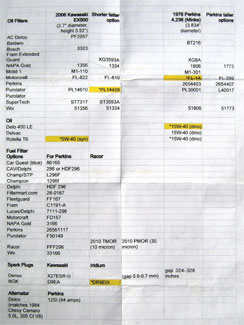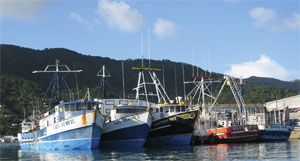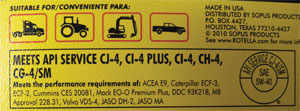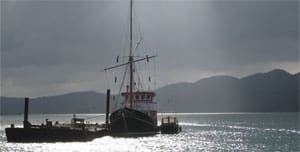Remember when you used to read those magazine articles about voyaging off into the sunset to get away from it all? And now that you’re out there doing it, you realize that to stay out there you need to be more organized than you used to be, with more lists of things to do, and your job description has grown longer by pages. Voyaging is really about repairing your boat in exotic places, so you have to embrace it or the voyage will be short, unpleasant and not have a happy ending.
Oil changes, filter changes, coolant changes, engine adjustments and lubrication, battery top-ups, pump maintenance and many other chores have their own schedules that will rule your life. When the hours are up, you will be doing your oil and filter changes or eventually you’ll be doing an engine change. We all know this and plan for this, but I have found that you need two lists to replace the one your significant other used to hand you as headed off to work.
Stop and shop
The first list is both content- and time-based. It is the list of routine maintenance stuff needed over the period of time between major stocking ports. What is a “major stocking port”? There is no master list, but they are generally easy to identify from afar. The surest sign of one is the presence of the very first-world Travelift-type of boat-hauling gear located in a marina with floating docks loaded with pleasure boats. These signs indicate a proximity to stores selling motor oil, filters, batteries, paint, etc. Chances are your voyaging plans will include a few of these, and for my part I try to include one every year for the annual haulout and maintenance binge.
Yes, it is possible to get hauled at fishing boat yards, commercial yards, etc., but in my experience the cost savings does not usually make up for the inconvenience. Often the cost savings of the cheap haulout place evaporates if you add in the necessity to take taxis to find stuff, or the need to ship in heavy supplies. Keep in mind too that in many parts of the world there is no reliable mail service and shipping is often very expensive. When I was in Colombia the cost to get a small FedEx box of mail was more than $50 (USD).
 |
|
John Kettlewell’s pocket list includes parts for boat and motorcycle. |
Twice is nice
In any case, I recommend a yearly arrival at your chosen haulout port where there is a reasonable chance of finding the quality and quantity of maintenance supplies you need. Obviously, the distance and time between two of these stops will determine the quantity of oil, filters, etc., needed. My rule of thumb is to have on board at all times a minimum of twice the quantity of these expendables I plan on using.
In other words, if I am expecting to run 200 engine hours during the year, that will add up to two complete oil changes and two oil filters, so I will have at least double those quantities of my preferred brands on board. By the way, the existence of oil recycling facilities are also limited to those first-world boatyards you will be seeking once a year, so please plan on retaining your dirty oil until you get someplace where you can dispose of it in an environmentally sound manner.
What quantity of engine coolant to bring is problematic. I have found that quality coolant is often harder to find than engine oil. I purchase coolant that is rated for five years of life anyway, so the need to completely replace it is low if I collect and reuse coolant when doing system repairs. I like to carry enough coolant to provide a complete change if needed, though I don’t plan on doing that very often. In a pinch it is certainly possible to use water from a reverse osmosis watermaker or even just plain drinking water. I always have at least one white plastic utility bucket and sealing lid on board that can be used to capture drained coolant when necessary. Being white makes it easy to see if it is clean before the coolant goes in.
Filters tend to be harder to locate than the proper oil and they are also easier to store, and basically last forever. I stock up when I find them at a reasonable price, so I often have multiple years’ worth on board. This is important, particularly for fuel filters, in case you have an emergency situation where filters are plugging up due to bad fuel. I know of voyagers who limped back to Florida from the Bahamas by changing fuel filters every few hours as they plugged up one after the other.
I choose a dry day with low humidity and then seal my filters in zipper-type freezer bags, then store them in plastic boxes in a dry spot. Stored like that, filters have lasted years on board in the tropics — so don’t be shy about bringing plenty.
 |
|
You might be hunting for supplies at a fishing boat dock instead of a marine supply store. |
The second list
This “double the spares” rule means if you get to that boatyard with the lift and there is no oil, or more likely they don’t have the right type of oil, you can probably make it to the next first-world marina before your maintenance situation becomes dire. This is where the second list comes into play. The first list — the master list — of everything you need and in what quantities is your on board list, while the second list is your pocket list, or backpack list, or maybe your phone list. It is the one you will always have on you as you explore the backstreets of exotic backwaters around the world.
The second list is the oil you need, the filters you’re running low on, the spark plugs for the dinghy outboard, etc., that you were unable to replenish at the last nice marina you were in almost a year ago. You never know when you’ll stumble upon a treasure of such stuff, and you have to pounce when you do. I remember feeling like a kid visiting a toy store when I walked into a fishing boat supply store in Honduras and there before me were racks of marine hardware, shelves full of oil, fresh-looking batteries, and so on. I spent several days anchored nearby just to make sure I had all the bits and bobs I needed on my various lists.
The same situation played out over the many weeks I spent in Cartagena, Colombia. My pocket list was always there if I spotted some auto parts store, or a hardware store in an odd spot. I found quality gasket-making material in one shop, another happened to have silicone sealant, one down on the waterfront happened to have two-stroke oil, while it took two or three shops to piece together the various hydraulic fittings I needed. None of these things were available in the small marine stores near the marinas, but I was always ready to switch into list mode while out sightseeing, etc.
Of course, it will be impossible to purchase the exact brand and quality of material you are replacing so it is important to have notes on the pocket list providing you with alternatives. Mine includes numerous filter types that cross-reference to my engine oil filter. It is important to get close to your engine oil specs, but don’t be surprised if you can’t find exactly what you want. In Panama I couldn’t easily locate my usual 15W-40 diesel engine oil so I had to make do with some Texaco-branded straight 40 I found in a large supermarket of all places. In Colombia I found a fast oil change car place that advertised Shell products and was able to order a case of diesel spec Rotella for me, but it was in different bottles and had different specs than oil I have purchased in the U.S. Luckily, my engine manual had a long list of alternate oils and specs that were allowable and I had notes on my pocket list.
 |
|
An important element of all your lists should be engine oil specifications so you can pick up oil when you run across it. |
For both lists I prefer to use the simple old paper list. Sure, store the information in a spreadsheet on your computer, but print out a few hard copies so these are always readily available. A paper list folded twice fits neatly into a zipper-type sandwich bag for water protection. You never know when you’ll be fueling up and you’ll spot something you need behind the counter, and you don’t want to be firing up your computer just to check your oil or filter specs. I keep the most important info on oil, filters and impellors written within the first few pages of my logbook so it is always handy.
Phone it in
Inevitably, there will be something you can’t locate in your exotic anchorage, so be prepared with a contact back home who is ready and willing to assist. Ideally, this person will be another boater or at least someone who is mechanically savvy and can locate that odd pump part that is impossible to find in Fiji. I like to have on board several marine master catalogs from places like Hamilton Marine, Defender and West Marine. Yes, the Internet is your friend, but connections are not always available and it can be useful to be able to compare images in the catalogs to the installed part on your boat. It is often better to order the parts yourself, have them shipped to your friend and then have that friend consolidate various orders and ship them to you when you arrive at a place with reliable connections to the outside world.
If your friend is capable, you can leave behind one of your master lists just in case you need him or her to hunt you up some new fuel filters. Always seize the opportunity of guest visits becoming parts delivery runs. My father arrived in Colombia with a suitcase bulging with unobtainable spares. Don’t worry, most guests will see it as part of the excitement of their exotic vacation!
John J. Kettlewell co-authored, with his wife Leslie, the Intracoastal Waterway Chartbook: Norfolk, Virginia, to Miami, Florida.

